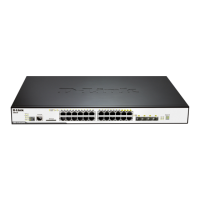xStack® DGS-3120 Series Layer 3 Managed Gigabit Ethernet Switch Web UI Reference Guide
108
Link aggregation is most commonly used to link a bandwidth intensive network device or devices, such as a server,
to the backbone of a network.
The Switch allows the creation of up to 32 link aggregation groups, each group consisting of 2 to 8 links (ports).
The (optional) Gigabit ports can only belong to a single link aggregation group.
All of the ports in the group must be members of the same VLAN, and their STP status, static multicast, traffic
control; traffic segmentation and 802.1p default priority configurations must be identical. Port locking, port mirroring
and 802.1X must not be enabled on the trunk group. Further, the LACP aggregated links must all be of the same
speed and should be configured as full duplex.
The Master Port of the group is to be configured by the user, and all configuration options, including the VLAN
configuration that can be applied to the Master Port, are applied to the entire link aggregation group.
Load balancing is automatically applied to the ports in the aggregated group, and a link failure within the group
causes the network traffic to be directed to the remaining links in the group.
The Spanning Tree Protocol will treat a link aggregation group as a single link, on the switch level. On the port level,
the STP will use the port parameters of the Master Port in the calculation of port cost and in determining the state
of the link aggregation group. If two redundant link aggregation groups are configured on the Switch, STP will block
one entire group; in the same way STP will block a single port that has a redundant link.
Port Trunking Settings
This window is used to configure the port trunk settings for the switch.
To view the following window, click L2 Features > Link Aggregation > Port Trunking Settings, as shown below:
Figure 4-41 Port Trunking Settings window
The fields that can be configured are described below:
Parameter Description
Algorithm
This is the traffic hash algorithm among the ports of the link aggregation group. Options to
choose from are MAC Source, MAC Destination, MAC Source Destination, IP Source, IP
Destination, IP Source Destination, L4 Port Source, L4 Port Destination, and L4 Port Source

